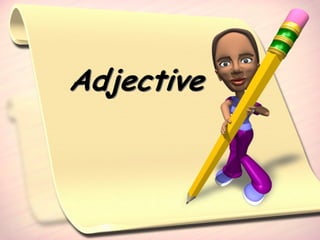
Adjectiveadverb
- 1. Adjective
- 2. Adjective Happy แปลว่ามีความสุข ขยายคานาม เป็น Adjective Adjective (คุณศัพท์) คือคา วลี หรือประโยค ซึ่งใช้อธิบายหรือ ขยายคานาม หรือสรรพนาม ให้ได้ ความชัดเจนยิ่งขึ้น กล่าวคือเป็น การบอกให้รู้ลักษณะคุณสมบัติของนามหรือสรรพนามนั้นว่าเป็น อย่างไร เช่น good, bad, new, hot, my, this
- 3. Adjective โดยทั่วไปการวางตาแหน่ง คุณศัพท์ในประโยคจะวางได้ 2 แบบ • ใช้วางประกอบข้างหน้านามที่มันขยาย She is a beautiful girl. เธอเป็นคนสวย These are small envelopes. พวกนี้เป็นซองเล็กๆ • ใช้วางเป็นส่วนของกริยา โดยอยู่ตามหลัง verb to be เมื่อ adjective นั้นขยาย noun หรือ pronoun ที่อยู่หน้า verb to be The girl is beautiful. เด็กผู้หญิงคนนั้นสวย These envelopes are small. ซองพวกนี้มีขนาดเล็ก
- 4. Adjective คุณศัพท์ต่อไปนี้ที่ประกอบหน้านามไม่ได้ ต้องวางหลัง verb to be หรือ linking verb alike เหมือน afraid กลัว asleep หลับ alone โดยลาพัง awake ตื่นอยู่ alive มีชีวิตอยู่ aware ระวัง ashamed ละอาย afloat ลอย unable ไม่สามารถ content พอใจ worth มีค่า ill ป่วย well สบายดี These two women look alike. ผู้หญิง 2 คนนี้ดูเหมือนกัน The boy is asleep. เด็กชายกาลังนอนหลับ * linking verb หมายถึง กริยาที่ใช่เชื่อมประธาน ( Subject) กับคาอื่นให้สัมพันธ์ กันเพื่อช่วย ขยายประธานของประโยค ให้ได้ใจความสมบูรณ์ที่นอกเหนือไปจาก verb to be เช่น appear, become, feel, get, grow,keep, look, go, remain, seem, smell, sound, taste, turn.
- 5. Adjective เมื่อ adjective หลายคาประกอบคานามเดียว ควรวางลาดับก่อนหลังดังนี้ Article บอก คาอธิบายลักษณะ นามรองทา นามหลัก Demonstrative จานวน คุณภาพ รูปร่าง อายุ สี แหล่ง วัสดุ หน้าที่ Possessive นับ ขนาด กาเนิด คุณศัพท์ Indefinite Adjective A Beautiful old Italian touring car The Four gorgeous red Rose some delicious Thai food คุณศัพท์ที่เป็นสมญานามไปขยายคานามที่เป็นชื่อเฉพาะ ให้วางหลังคานามนั้นเสมอ เช่น Alexander the Great William the Conqueror กลุ่มของคาที่เป็นวลี ( phrase) หรืออนุประโยค ( clause ) เมื่อขยายคานาม ต้องวางหลัง นามหรือสรรพนามที่มันประกอบ เช่น The woman sitting in the chair is my mother . ผู้หญิงที่นั่งที่เก้าอี้เป็นแม่ของฉัน
- 6. Type of Adjective Attractive, dark hair, kind of like, mysterious, you know, really amazing girl คาที่ระบายสี เป็น adj ขยายลักษณะของผู้หญิงคนหนึ่ง เรียกว่า Descriptive Adjective หรือ คุณศัพท์แสดงคุณสมบัติ
- 7. Descriptive Adjective (คุณศัพท์แสดงคุณสมบัติ) weak/strong dark/light beautiful/ugly fancy/plain full/empty fat/thin heavy/light large/small long/short narrow/wide old/new old/young quiet/loud
- 8. Type of Adjective Possessive Adjective เป็นคาคุณศัพท์ประกอบหน้านาม เพื่อแสดงความเป็นเจ้าของ เช่น my , your, his , her, its, their our This is my ball. This is our snowman. They are his family.
- 9. Type of Adjective Proper adjective ( คุณศัพท์แสดงสัญชาติ ) เป็นคาคุณศัพท์ที่ขยายนามเพื่อบอกสัญชาติ มีรูป เปลี่ยนแปลงมาจาก Proper noun และต้องขึ้นต้นด้วยตัวใหญ่เสมอ เช่น Chinese, French - - We learn the French literature every Monday. He is Scottish. He is reading an English document.
- 10. Type of Adjective Quantitative Adjective ( คุณศัพท์แสดงปริมาณที่นับไม่ได้ ) เป็น คาคุณศัพท์บอกปริมาณ ขยายนามที่นับไม่ได้ (uncountable noun ) เพื่อบอกให้ทราบปริมาณของสิ่งนั้น ว่ามีมากหรือน้อย แต่ไม่บอก จานวนแน่นอน เช่น much, any, half, enough, little We needed some money. เราต้องการเงินจานวนหนึ่ง Has he got much money?
- 11. Adverb I wanna thank you for giving me time to breathe, Like a rock, you waited so patiently, while I got it together, While I figured it out Patiently คือ adverb Adverb ( กริยาวิเศษณ์ ) คือคาที่ใช้ประกอบหรือขยายคาต่อไปนี้เพื่อให้ได้ ความหมายชัดเจนยิ่งขึ้น Verb (กริยา) เช่น He works hard every day. Adjective ( คาคุณศัพท์) เช่น It is surprisingly hot today. คากริยาวิเศษณ์ด้วยกันเอง เช่น The train travels very quickly. กลุ่มคาที่เป็นวลี เช่น They lived nearly on the top of the hill. จานวนนับ เช่น I go to Huahin almost every week. Preposition (บุพบท) เช่น I hit him right on his nose.
- 12. Type of Adverb Adverbs of Degree เป็นกริยาวิเศษณ์ส่วนใหญ่ไปขยาย adjective หรือ adverb ด้วยกันเอง เพื่อบอกระดับหรือปริมาณ ความมากน้อย Absolutely, certainly, definitely, probably, entirely, obviously, very มักจะขยาย adjective หรือ adverb ด้วยกันเอง และวางหน้า main verb This ice-cream is extremely big. ไอติมโคนนี้ใหญ่มาก I am too tired to go out tonight. ฉันเหนื่อยเกินไปกว่าที่จะออกไปข้างนอกคืนนี้
- 13. Type of Adverb Adverbs of Time เป็น adverb ที่ บอกว่าการ กระทานั้นเกิดเมื่อใด / เป็นเวลานานแค่ไหน / และบ่อยแค่ ไหน today, yesterday, all day, not long, sometimes การวางตาแหน่งของ Adverbs of time • Adverb ที่บอกว่าเกิดเมื่อใด (When) ส่วนมากจะ นิยมวางท้ายประโยค It was snowing last night
- 14. Type of Adverb • Adverb of time ส่วนมากจะวางไว้ในกลางประโยค ไม่ได้ ยกเว้น now, once, และ then • Adverb ที่บอกว่าบ่อยแค่ไหน ( how often ) เป็นการแสดงความถี่ของการกระทา ส่วนมากวางหน้า กริยาหลัก แต่หลังกริยาช่วย I had often gone to the beach when I was young.
- 15. Type of Adverb Adverbs of Manner เป็น adverb ที่บอกว่าการกระทา นั้นได้ กระทาในลักษณะอาการอย่างไร ส่วนมากจะเป็น adverb ที่ลงท้ายคาด้วย -ly Actively, any how, aggressively, loudly การวางตาแหน่งของ Adverbs of Manner • ถ้าประโยคไม่มีกรรมให้วางหลังกริยา He talks loudly
- 16. Type of Adverb • ถ้าประโยคนั้นมีกรรม ให้วางหลังกรรม I can speak Japanese well. • Adverb of Manner ที่ลงท้ายด้วย -ly หรือเป็นคาที่แสดง ความเห็นของผู้พูดเกี่ยวกับการกระทานั้น ส่วนใหญ่นิยมวางไว้ ในประโยค I have carefully considered all of the possibilities.
